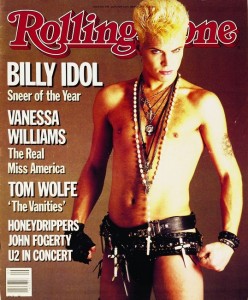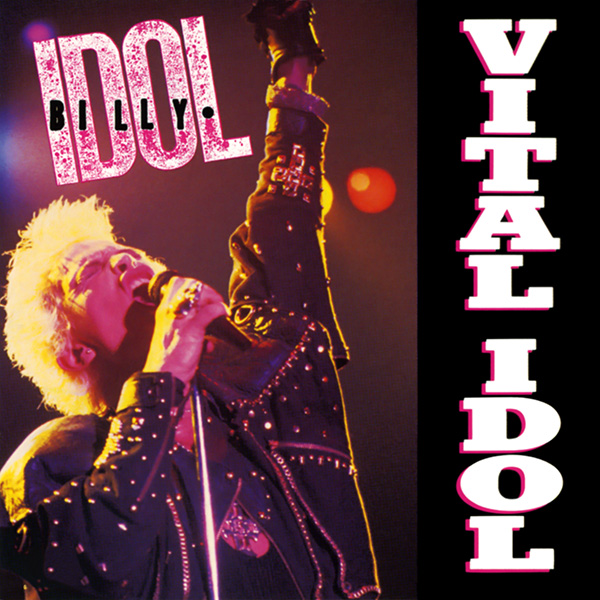Welcome to another installment of Wandering the Aisles, where we bypass record stores and online retailers for what may be the strangest venue to buy music: the discount bin at your local supermarket! Non-believers will scoff, but true fans know it’s possible to find some buried treasure in these discounted discs…as long as you don’t mind the occasional bit of fool’s gold along the way.
Today, we tackle one of the most iconic pop stars of the early 1980s, as you’ve barely heard him before…in remix album form! Wandering the Aisles dissects the pop-rock-dance offerings of Billy Idol’s Vital Idol.
Everyone loves to mention the same few things about Idol’s career. The impossibly spiky hair, his roots in England’s punk rock scene, his propensity for leather pants, his incredibly bizarre foray into cyberpunk culture – those are all things we talk about when we talk about Billy Idol. What we don’t discuss is the big lie that has stuck with Idol’s career for nearly three decades: the myth that the singer born William Michael Broad is a full-blooded rocker.
 Don’t let the supposed evidence fool you. Idol may enjoy a longtime collaboration with Steve Stevens, one of the best ballsy guitarists of the ’80s. He may have sneered and spat in public enough to make parents think twice before allowing their kids to go to his concerts. And his 2005 comeback album, Devil’s Playground, was all blustery rock, all the time. But the essence of Idol is pure pop for the MTV generation. And it’s a style that bridged the synths-and-big-drums sound of the ’80s with the bubblegum hooks of the ’60s.
Don’t let the supposed evidence fool you. Idol may enjoy a longtime collaboration with Steve Stevens, one of the best ballsy guitarists of the ’80s. He may have sneered and spat in public enough to make parents think twice before allowing their kids to go to his concerts. And his 2005 comeback album, Devil’s Playground, was all blustery rock, all the time. But the essence of Idol is pure pop for the MTV generation. And it’s a style that bridged the synths-and-big-drums sound of the ’80s with the bubblegum hooks of the ’60s.
Sometimes the influence is obvious; his repertoire includes covers of Tommy James and The Shondells’ “Mony Mony” (which Idol took to No. 1 in 1987) and William Bell’s “I Forgot to Be Your Lover,” two acts about as far removed from punk as possible. But listening to most of his singles, you’d never imagine that this guy was a punk. So many of his tracks trade distorted guitar for jaunty, keyboard-led hooks (dig the pseudo-soul piano in the bridge of “Hot in the City”) and are heavy on lovelorn lyrics (“Eyes Without a Face” and “Catch My Fall” were slow-danced to by about 80% of teens of a certain generation).
Still not convinced? Consider this: what self-respecting rocker would release a stopgap collection of dance remixes? Even Huey Lewis and The News, the most guilt-free, easygoing pop-rockers of the decade (and, alongside Idol, an act on the Chrysalis label), didn’t pull that kind of stunt. Bottom line: Billy Idol is a pop star – one wearing leather and chains, but a pop star nonetheless. And, as Vital Idol (first released in the U.S. in 1987) reminds us, he was a pretty darn good one, too.
 The set does do everything in its power to distract you from Billy Idol’s pop mastery. The set leads off with Idol’s most fist-in-the-air tune, the irrepressible “White Wedding.” Now extended to include both the hit Part I and the sequencer-heavy, single-only Part II, it’s there to lull you into a false sense of rock security. After the first eight minutes of little sisters and starting agaaaaaaaaain, you’re hit with remixes of some of Idol’s poppiest offerings: “Mony Mony,” “Hot in the City” and “Dancing with Myself.” None of these tunes would be unorthodox had they been recorded in 1968 (one of them, of course, actually was), but what’s really interesting is how obvious the remixes make those bubblegum undertones. The overdubs and extensions emphasize the most basic elements of Idol’s melodic and lyrical structures, and you’re left with a set that’s going to make you move your feet before you bang your head.
The set does do everything in its power to distract you from Billy Idol’s pop mastery. The set leads off with Idol’s most fist-in-the-air tune, the irrepressible “White Wedding.” Now extended to include both the hit Part I and the sequencer-heavy, single-only Part II, it’s there to lull you into a false sense of rock security. After the first eight minutes of little sisters and starting agaaaaaaaaain, you’re hit with remixes of some of Idol’s poppiest offerings: “Mony Mony,” “Hot in the City” and “Dancing with Myself.” None of these tunes would be unorthodox had they been recorded in 1968 (one of them, of course, actually was), but what’s really interesting is how obvious the remixes make those bubblegum undertones. The overdubs and extensions emphasize the most basic elements of Idol’s melodic and lyrical structures, and you’re left with a set that’s going to make you move your feet before you bang your head.
Billy Idol – “White Wedding (Part 1)”
There are a few moments of heaviness throughout the 49 or so minutes it takes to listen to Vital Idol. Remixes of “Flesh for Fantasy” and “To Be a Lover” turn up the guitars, and Idol lays on the hedonistic-rock-god persona early on in both tracks by including what sounds like sampled transmissions from phone sex hotlines. But bouncy, dub-inspired grooves on the final two tracks, “Love Calling” and “Catch My Fall,” bring us right back into the mainstream.
Vital Idol, it should be noted, also succeeds as remixes rarely do. These aren’t the same sort of hastily-extended, heavily-reverbed versions you’d expect from most 12″ singles. If you’ve heard all of these tunes to death in their original incarnations – and if you were big on MTV in its early years, you surely had – you’re going to hear some things you never thought you’d notice, whether it’s the funky bass in “Flesh for Fantasy” or Idol’s surprising versatility as a vocalist (the extra vocals on “White Wedding” do a lot to prove this).
Billy Idol and his compilers may not want you to think about Idol’s obvious position as a pop star in one of the most shameless ages of pop music. (The liner notes the current CD version of Vital Idol, for instance, are more interested in Idol fusing rock with dance.) Idol himself has done little to illuminate his softer side; one can only hope his recently-announced autobiography will at least touch on his pop sensibilities alongside the sex, drugs and rock and roll. But if you want to know the truth – that Billy Idol stands for pop as much as a barrel full of VMAs – Vital Idol is the set to buy.





Comments